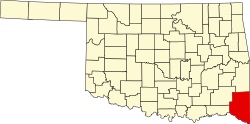Tom, Oklahoma | |
|---|---|
 | |
| Coordinates: 33°44′09″N94°34′23″W / 33.73583°N 94.57306°W [1] | |
| Country | United States |
| State | Oklahoma |
| County | McCurtain |
| Elevation | 371 ft (113 m) |
| Time zone | UTC-6 (Central (CST)) |
| • Summer (DST) | UTC-5 (CDT) |
| ZIP codes | 74740 |
| GNIS feature ID | 1101695 [1] |

Tom is an unincorporated community in McCurtain County, Oklahoma, United States.


